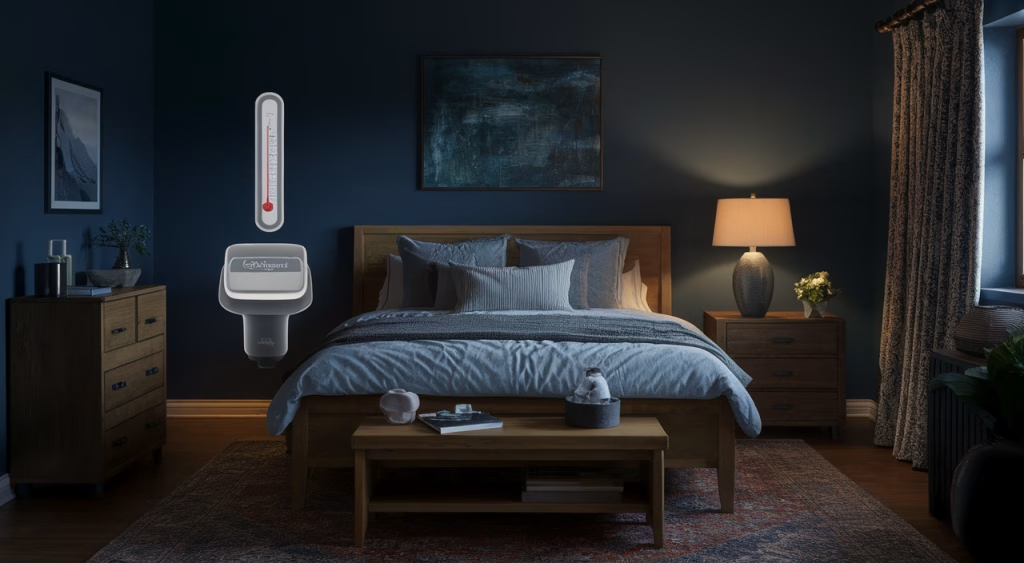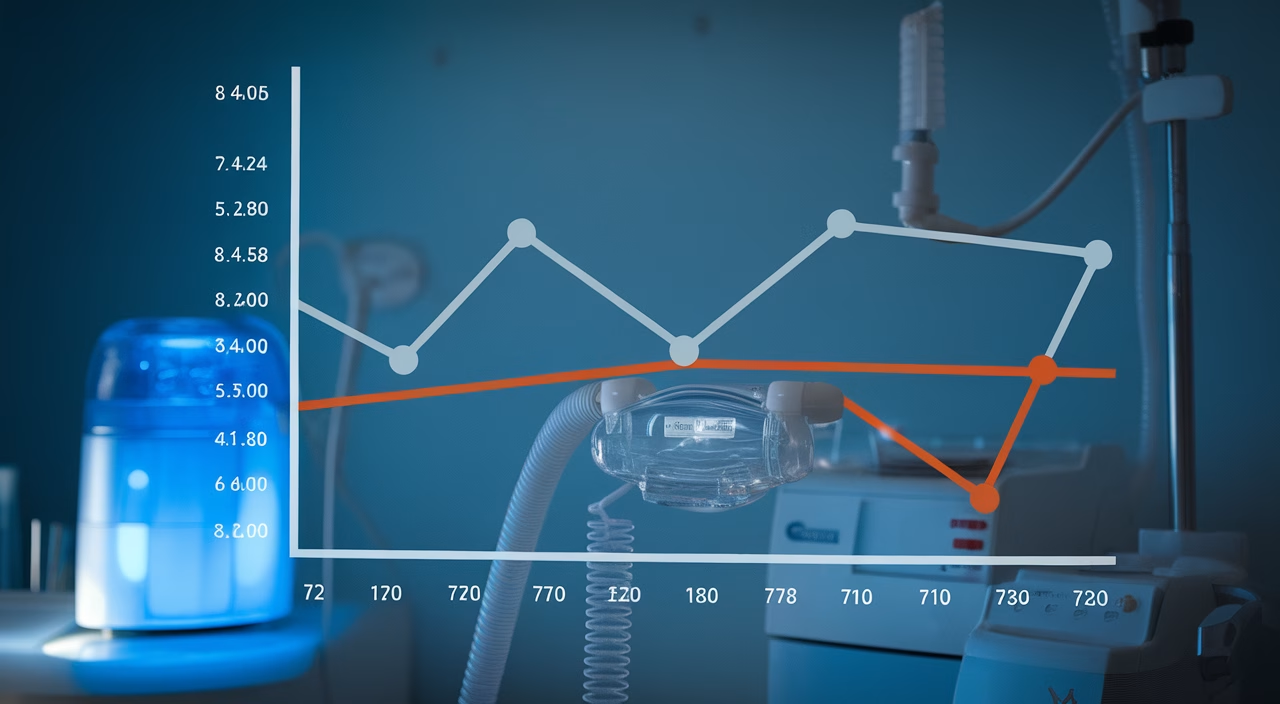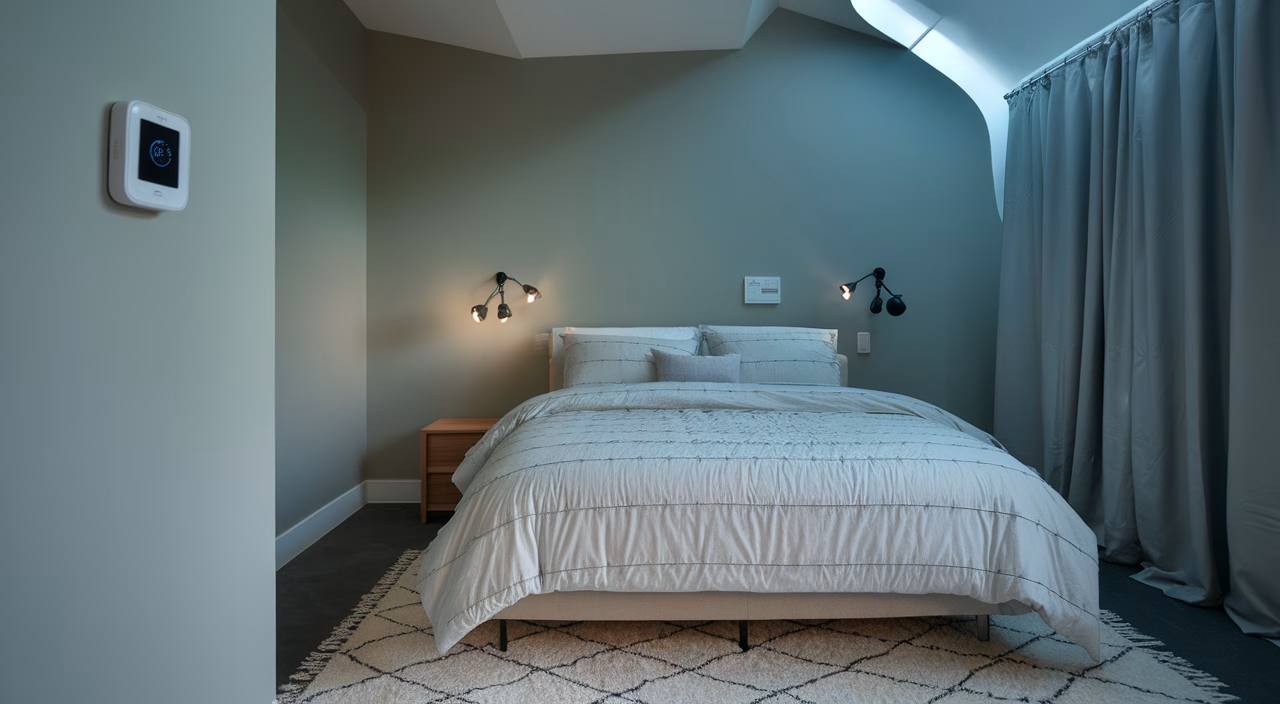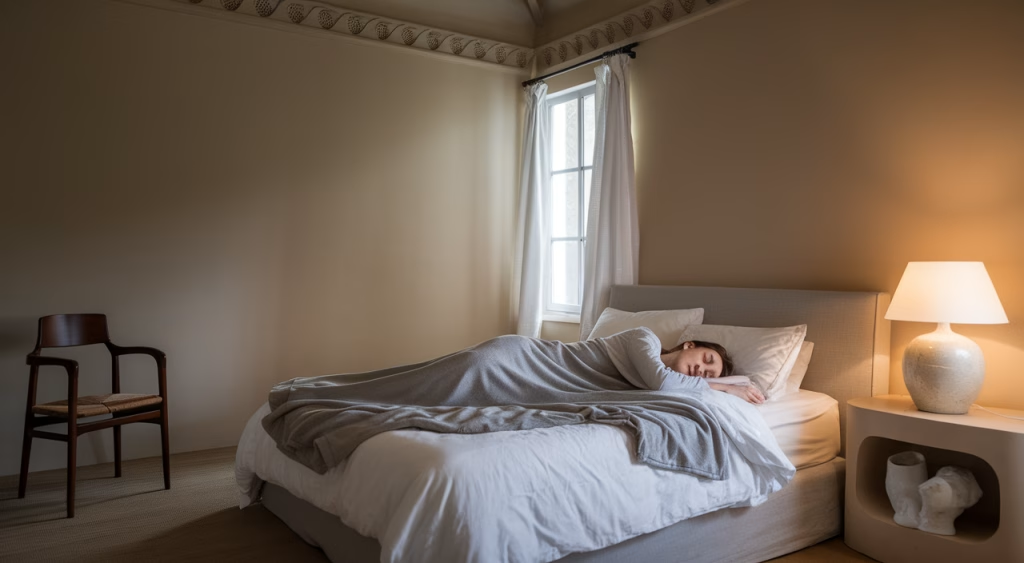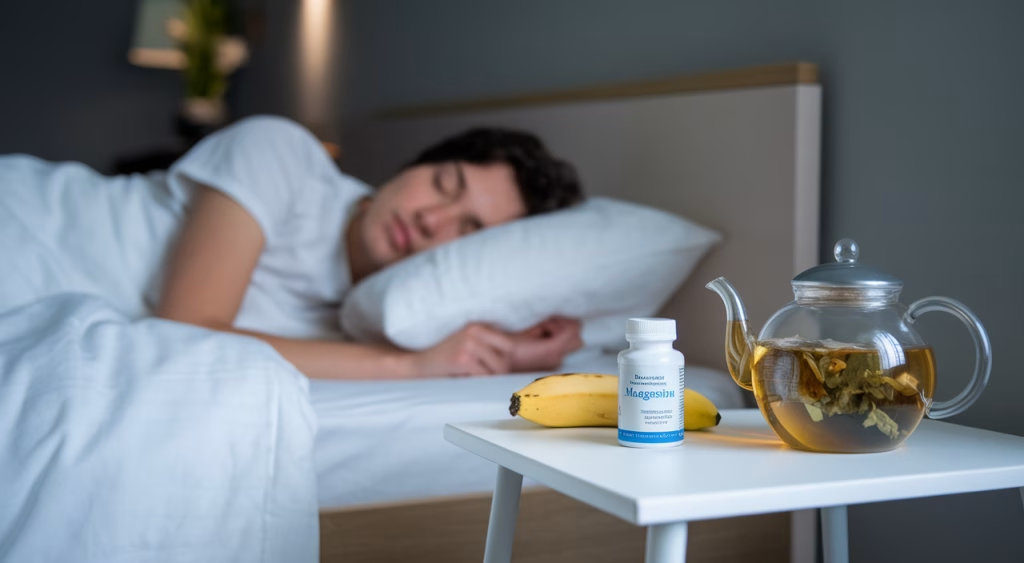How Room Temperature Affects Your Sleep Apnea
Room temperature directly influences airflow, respiratory effort, and sleep cycles—three pillars of restful sleep for anyone dealing with obstructive sleep apnea. When your bedroom is too hot or too cold, it disrupts breathing patterns, reduces sleep efficiency, and can make your CPAP therapy less effective. Research shows that maintaining the right ambient temperature—typically between 60–67°F (15.6–19.4°C)—can significantly improve your sleep quality and reduce sleep apnea symptoms.
TL;DR Summary
- Ambient temperature significantly influences sleep for those with obstructive sleep apnea.
- Ideal room temperature generally falls between 60–67°F (15.6–19.4°C) for most adults.
- Too hot or cold environments can increase respiratory effort and awakenings at night.
- CPAP users may experience dry mouth or nasal congestion if temperature and humidity aren’t optimized.
- Practical fixes include adjusting bedding, controlling HVAC, and monitoring indoor climate with smart sensors.
- Personalized recommendations based on sleep patterns can improve long-term sleep efficiency.
The Impact of Ambient Temperature on Sleep Apnea
If you’ve ever tossed and turned on a sweltering summer night or shivered under blankets in winter, you know how sensitive sleep is to ambient temperature. When you’re living with obstructive sleep apnea, minor thermal discomfort becomes much more serious—it can worsen sleep apnea symptoms, reduce CPAP therapy effectiveness, and sabotage your rest.
Research reveals that warmer temperatures result in shallower sleep and more respiratory events. When your room temperature is too hot, your body struggles to cool down, leading to frequent awakenings and fragmented REM cycles. Conversely, sleeping in overly cold conditions causes nasal passages to constrict, making it harder to breathe through your nose—especially problematic if you use CPAP therapy.
Your body’s temperature regulation and sleep patterns are deeply interconnected. When ambient temperature strays too far from optimal levels, it disrupts your circadian rhythms and suppresses melatonin production—a hormone critical for maintaining healthy sleep patterns.
Understanding Sleep Efficiency
Sleep efficiency—the percentage of time you actually sleep while in bed—is a key indicator of sleep quality for those with sleep disorders. Poor ambient temperature can dramatically reduce sleep efficiency by prolonging the time it takes to fall asleep and increasing nighttime awakenings.
For people with sleep apnea, efficiency means more than just getting enough hours. Quality trumps quantity every time. When you achieve high sleep efficiency, you experience fewer breathing interruptions and deeper, more restorative rest. Proper temperature control helps your body cycle smoothly through non-REM and REM stages—both essential for recovery.
Ever noticed that your CPAP therapy feels less effective on certain nights? Your room temperature could be the culprit. Uncomfortable temperatures may cause you to unconsciously remove your mask or shift into positions that worsen sleep apnea episodes.
Why CPAP Therapy and Temperature Control Go Hand in Hand
CPAP therapy is the gold standard for managing moderate to severe obstructive sleep apnea. However, its effectiveness depends heavily on environmental factors—especially ambient temperature and humidity levels.
Here’s how it works: Your CPAP machine delivers continuous airflow to prevent airway collapse. If the air is too cold or dry, it irritates your nasal passages, causing congestion, dryness, or sinus problems. Conversely, if the air is too warm and humid, you’ll experience mask sweating and discomfort that may lead you to abandon therapy during the night.
We see this pattern frequently: On cold nights, people crank up their heaters, which dries out their rooms. The resulting drop in humidity thickens nasal mucus and increases airway resistance—hardly ideal when you’re already working to breathe comfortably. A heated humidifier helps, but it works best when paired with optimal room temperature.
| Temperature Range | Effect on CPAP Therapy |
|---|---|
| 50–59°F (10–15°C) | Discomfort, mask leaks, nasal congestion |
| 60–67°F (15.6–19.4°C) | Optimal comfort and airflow, better sleep efficiency |
| 68–75°F (20–23°C) | Risk of sweating, disrupted REM sleep |
Managing Sleep Patterns with Temperature
Your sleep patterns can vary based on lifestyle, age, and health conditions. Some people naturally run warm, while others always seem to need extra blankets. Regardless of where you fall on that spectrum, ambient temperature plays a fundamental role in your sleep architecture.
Consistent bedroom temperature helps stabilize your circadian rhythms. Sleep architecture—how you progress through various sleep stages—is highly sensitive to thermal discomfort. For those dealing with obstructive sleep apnea, even minor disruptions in deeper sleep phases can result in amplified daytime fatigue and cognitive issues.
We frequently observe this pattern in sleep clinics: A patient maintains excellent sleep hygiene and uses their CPAP nightly, but still wakes up exhausted. A quick review of their bedroom setup reveals room temperature fluctuating more than 5°F overnight. Stabilizing that ambient temperature often produces dramatic improvements.
That’s why tools like smart thermostats or temperature logs are invaluable. They help you find your ideal range and maintain it consistently night after night.
Practical Tips for Improving Sleep Quality
Let’s get tactical. Here are expert-backed steps you can take to optimize your sleep environment for better breathing, deeper rest, and fewer middle-of-the-night interruptions:
1. Find Your Optimal Sleep Temperature
Most people with sleep apnea thrive between 60–67°F. But listen to your body—you may sleep better on the cooler or warmer side of that range. What matters most is consistency.
2. Choose Light, Breathable Bedding
Heavy layers trap body heat, leading to night sweats and restlessness. Opt for moisture-wicking materials like cotton or bamboo-derived fabrics that help regulate ambient temperature naturally.
3. Install Smart Temperature Controls
Block external heat gain or cold drafts with thermal curtains. Consider smart monitors that alert you when your room temperature fluctuates beyond your ideal range.
4. Position Your CPAP Away from Vents
Direct airflow from heating or cooling vents can affect your CPAP’s air temperature and reduce therapy effectiveness. Place your unit in a stable zone free from temperature fluctuations.
5. Monitor Humidity Alongside Temperature
Maintain 40–50% indoor humidity to ensure optimal nasal function. This supports comfortable breathing during CPAP therapy and helps prevent sleep apnea symptoms from worsening.
Cost Guide: Environmental Tools That Can Help
Improving your bedroom’s sleep environment doesn’t require a massive budget. Whether you’re beginning with basics or upgrading with smart tools, here’s a cost breakdown:
| Item | Low-End | Mid-Range | High-End |
|---|---|---|---|
| Smart Thermostat | $60 | $130 | $250+ |
| Humidifier with Hygrometer | $30 | $75 | $150+ |
| Thermal Curtains | $40 | $80 | $150 |
| Cooling Mattress Pad | $60 | $150 | $300+ |
| Temperature Monitor | $20 | $50 | $100+ |
Final Thoughts
Optimizing ambient temperature isn’t just a comfort upgrade—it’s a critical strategy for managing obstructive sleep apnea effectively. While CPAP therapy addresses the mechanical aspects of breathing disruptions, your sleep environment plays an equally important role in supporting or undermining your efforts.
Making thoughtful adjustments to your bedroom temperature can dramatically boost your sleep efficiency, improve CPAP therapy compliance, and reduce daytime fatigue. The key lies in personalization: What feels too cold for one person might be perfect for another. Experiment with different settings, monitor your responses, and let your sleep patterns guide your optimization journey.
Remember, your best sleep starts with finding that perfect ambient temperature.
Frequently Asked Questions
Does room temperature affect snoring?
Yes. Warmer rooms can increase nasal congestion, while cold air may trigger airway constriction—both of which increase the likelihood of snoring, especially in those with sleep apnea.
What is the best temperature for sleep apnea sufferers?
Between 60–67°F (15.6–19.4°C). This range helps regulate body temperature, reduces respiratory effort, and supports better CPAP therapy outcomes.
Can changing my bedroom temperature improve CPAP compliance?
Absolutely. Optimal room temperature reduces discomfort and prevents dryness or mask irritation, both of which can interfere with CPAP usage.
What signs suggest my room is too warm or cold for sleep?
Frequent awakenings, excessive sweating, dry mouth, or nasal congestion during sleep may indicate an imbalanced room temperature.
Should I use a fan or space heater to regulate temperature?
Only if they maintain a stable, appropriate temperature. Fans can help circulate cool air, while heaters should include thermostatic controls to prevent overheating.
How does humidity interact with sleep temperature?
Humidity affects how temperature feels. Low humidity in cold rooms dries out nasal passages, while high humidity in warm rooms increases sweating and discomfort.
Can children or elderly patients have different temperature needs?
Yes. Both groups may have different thermal comfort thresholds and may need slightly warmer temperatures (65–70°F) for safe and restful sleep.
{“@context”:”https://schema.org”,”@type”:”BlogPosting”,”headline”:”Optimizing Ambient Temperature for Better Sleep with Obstructive Sleep Apnea”,”description”:”Discover how room temperature affects your sleep apnea and how to improve your sleep quality naturally.”,”datePublished”:”2024-04-27″,”publisher”:{“@type”:”Organization”,”name”:”Stop Snoring Today”,”logo”:{“@type”:”ImageObject”,”url”:”https://stopsnoringtoday.net/wp-content/uploads/stop-snorning-today.jpg”}},”mainEntityOfPage”:{“@type”:”WebPage”,”@id”:”https://stopsnoringtoday.net/”},”keywords”:[“ambient temperature and sleep apnea”,”CPAP therapy”,”improving sleep efficiency”,”sleep apnea symptoms”,”sleep patterns”,”sleep disorders”,”room temperature effects on sleep apnea”,”best temperature for sleep apnea”,”room temperature and sleep apnea”],”mainEntity”:[{“@type”:”Question”,”name”:”Does room temperature affect snoring?”,”acceptedAnswer”:{“@type”:”Answer”,”text”:”Yes. Warmer rooms can increase nasal congestion, while cold air may trigger airway constriction—both of which increase the likelihood of snoring, especially in those with sleep apnea.”}},{“@type”:”Question”,”name”:”What is the best temperature for sleep apnea sufferers?”,”acceptedAnswer”:{“@type”:”Answer”,”text”:”Between 60–67°F (15.6–19.4°C). This range helps regulate body temperature, reduces respiratory effort, and supports better CPAP therapy outcomes.”}},{“@type”:”Question”,”name”:”Can changing my bedroom temperature improve CPAP compliance?”,”acceptedAnswer”:{“@type”:”Answer”,”text”:”Absolutely. Optimal room temperature reduces discomfort and prevents dryness or mask irritation, both of which can interfere with CPAP usage.”}}]}

